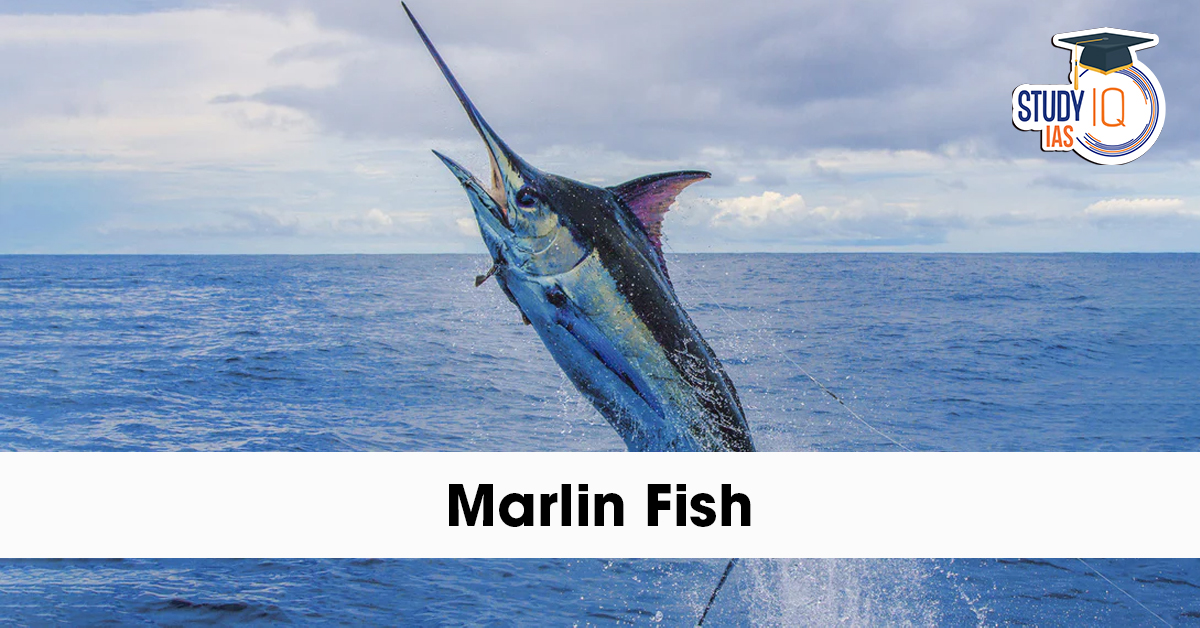Context: A 28-year-old man went missing off the coast of Kerala after reportedly engaging in a dangerous duel with a marlin fish.
What Is a Marlin Fish?
Family & Species
- Marlins belong to the billfish group (Xiphioidea), within the family Istiophoridae.
- They are related to swordfish, but taxonomically closer to tuna and mackerels.
- There are around 10–11 recognized species of marlin.

Size & Appearance
| Species | Length | Weight | Notable Features |
| Blue marlin (Makaira nigricans) | Up to 5 m (14–16 ft) | ≈900 kg (2,000 lb) | Cobalt-blue above, silvery below, tall, dynamic dorsal fin. |
| Black marlin (Istiompax indica) | Over 5 m | >670 kg; record ≈700 kg | Rigid, non‑retractable pectoral fins, renowned speed |
| Striped marlin (Kajikia audax) | Up to ~4.2 m | ~220 kg | Bluish vertical stripes can glow before hunting |
All marlins feature
- A long, spear‑like bill used to slash and stun prey.
- Highly streamlined bodies, deep forked tails, and powerful muscles adapted for high-speed bursts.
Speeds & Hunting
- Among the fastest fish: Striped marlin clock ~110 km/h, black marlin are comparable
- Hunting method: They slash through schools of smaller fish (tuna, mackerel, sardines), stunning them before catching
- The striped marlin exhibits intriguing fluorescent “glow” behaviour before attacks—likely coordination or confusion tactics
Distribution & Lifecycle
- Highly migratory, crossing entire ocean basins, blue marlin have been tagged, moving from the Atlantic to the Indian Ocean
- Habitat: Prefer warm, open‐water (“blue‐water”) pelagic zones above ~20 °C
- Reproduction: Broadcast spawners—one female can release millions of eggs; marlin larvae are pelagic
Physiology & Adaptations
- Like other billfish, marlins have a counter-current heat exchanger to warm their brain and eyes, enhancing hunting focus and vision
- Color-change ability: Marlins can shift skin patterns rapidly via iridophores and chromatophores—used for camouflage, communication, and the striped marlin’s glow
Status & Conservation
- Blue and white marlin are listed as Vulnerable, due to intense fishing and bycatch
- Black marlin status is data-deficient, but concerns arise from overfishing and sports fishing pressure
- Conservation measures: Legislation like the US Billfish Conservation Act, catch-and-release programs, and tagging initiatives help track and protect them
Why They Captivate Humans
- Sport fishing icons—hooking a marlin is considered the ultimate big-game achievement
- Cultural lore: Featured in Hemingway’s The Old Man and the Sea, and names of sports teams (e.g., Miami Marlins)


 Bonnet Macaques: Habitat, Features, Beha...
Bonnet Macaques: Habitat, Features, Beha...
 Periyar Tiger Reserve, Map, Flora, Fauna...
Periyar Tiger Reserve, Map, Flora, Fauna...
 Project Cheetah in India, Objectives, Ch...
Project Cheetah in India, Objectives, Ch...

























